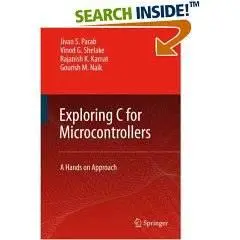Jivan S. Parab, Vinod G. Shelake, Rajanish K. Kamat, Gourish M. Naik , "Exploring C for Microcontrollers A Hands on Approach"
Springer; 1 edition (July 11, 2007) | ISBN:1402060661 | 157 pages | PDF | 9 Mb
Springer; 1 edition (July 11, 2007) | ISBN:1402060661 | 157 pages | PDF | 9 Mb
The market is flooded with numbers of good books on Embedded Systems designed especially with the most popular MCS51 family. These books are traditional in nature i.e. they start with the routine architectural features of 8051, description of registers, ports, interrupts etc. Most of these things are already covered in the device data sheet and application notes. In this book all such routine things are skipped. The focus is on programming microcontrollers, to be specific MCS-51 family in ‘C’ using Keil IDE. The book presents seventeen live case studies apart from the many basic programs organized around every on-chip resource like port, time/counter, interrupt , serial I/O etc. Rather than introducing the underpinning theory or reproducing lengthy data sheets, our approach is "learning-through-doing" and one that appeals to busy electronics designers. The ‘C’ codes given are well supported by easy to understand comments wherever required. Mastering the basic modules and hands on working with the projects will enable to grasp the basic building blocks for most 8051 programs. Whether you are a student using the MCS-51 family of microcontrollers for your project work or an embedded systems programmer, this is a book that will give you a kick-start in using and understanding the most popular microcontroller.
Authors through their interaction with the undergraduate, postgraduate students as well as industry professionals have found that such a book is a need of the microcontroller community interested in C programming. The book will bridge the gap between the microcontroller hardware experts and the C programmers.



